










PUBLISHER
James R. Baker
GENERAL MANAGER
John Rusnak
EXECUTIVE EDITOR
Andy Walgamott
EDITOR
Chris Cocoles
CONTRIBUTORS
Mark Fong, Scott Haugen, Tiffany Haugen, Tim E. Hovey, Cal Kellogg, Mike Pawlawski
SALES MANAGER
Paul Yarnold
ACCOUNT EXECUTIVES
Janene Mukai, Tom St. Clair
DESIGNERS
Gabrielle Pangilinan, Lesley-Anne Slisko-Cooper
PRODUCTION ASSISTANT
Emily Baker
DIGITAL STRATEGIST
Jon Hines
ADMINISTRATIVE ASSISTANT
Katie Aumann
INFORMATION SERVICES MANAGER
Lois Sanborn
Volume 17 • Issue 1
ADVERTISING INQUIRIES ads@calsportsmanmag.com
CORRESPONDENCE
Email ccocoles@media-inc.com
X @CalSportsMan Facebook.com/californiasportsmanmagazine
ON THE COVER
West Coast sportsman Buzz Ramsey scored a beautiful Rio Grande turkey during a fall hunt. California’s autumn gobbler season runs from November 9 through December 8. (BUZZ RAMSEY)
MEDIA INC PUBLISHING GROUP 941 Powell Ave SW, Suite 120 Renton, WA 98057 (800) 332-1736 • Fax (206) 382-9437 media@media-inc.com www.mediaindexpublishing.com






Cal Kellogg is thankful for the California fall turkey hunt that runs from November 9 through December 8. And with Thanksgiving approaching, why not get outside and score a holiday gobbler for your family meal? Kellogg details the differences from the spring season – “It’s mostly woodsmanship that puts birds in the roaster during the fall” – and offers up tips for coming back with dinner.
GOLDEN BEAR VERSUS GRIZZLY BEAR
Mike Pawlawski, a former star college quarterback for the Cal Golden Bears, a longtime Arena Football League star turned outdoors TV host and motivational speaker, has written a book that’s part self-help tips and part adventures on the football field and in the hunting and fishing worlds. Check out a wild story about a charging Alaska grizzly excerpted from Pawlawski’s book.
31 CAUGHT ON CAMERA: IMPROVE DUCK DECOY SETUPS WITH GAME CAM INTEL
Waterfowl hunting gets into full swing this month throughout the state, and hunters shouldn’t overlook that cellular camera technology can be used to very effectively refine decoy spreads. Haugen shares some of his best caught-on-camera moments in our From Field to Fire feature that also includes a Tiffany Haugen hazelnut-infused duck recipe.
57 BRINGING TOGETHER A ‘UNION’ OF TROUT, MACKS
In a second appearance from Cal Kellogg this month, he takes us to a somewhat hidden gem among NorCal fisheries, the Eldorado National Forest’s Union Valley Reservoir. With hungry rainbows, hard-fighting browns and trophy Mackinaw, there is no shortage of opportunities for anglers to wet a line here.


In my other gig here at Media Inc. Publishing, I’m the editor of California Sportsman’s sister magazine, Alaska Sporting Journal.
With just about everyone I’ve interviewed to discuss their experience in the 49th state’s vast and wild landscapes, I make it a point to ask them if they had a welcome-to-Alaska moment.
If you’re not familiar with Alaska, you can expect the unexpected. It could be a sudden weather change; it could be skirmishes with wildlife; and it could be some of the best fishing or hunting memories you’ll ever make.
In an excerpt this month from his book (page 12), former quarterback and outdoors TV host Mike Pawlawski chronicled a harrowing confrontation with a charging grizzly bear during a filming expedition in Alaska’s Bristol Bay region.
But that wasn’t Pawlawski’s first experience in what’s known as the Last Frontier. So, during our lengthy discussion, I asked if he had an “Oh, %^&*: I’m in Alaska epiphany.”
When he and fellow University of California football alum Ben Lynch traveled to Alaska to film segments for the TV show Familiar Waters, there was a mixup with the host lodge on when they were to arrive, but no big deal; the crew was told they could get into some boats and fish in Lake Iliamna on their own that first day.
“They said to just take the boat and row to the top of the lake and hit the (Arctic) char run. ‘You’ll figure it out,’” Pawlawski told me with a laugh. “We get the boat to the top of the lake and we are hammering char with streamers. We’re having a great time, we’re filming and getting great underwater footage, and all of a sudden one of my camera guys said, ‘What time is it?’ I looked at my watch and, holy sh*t, it’s 2 a.m.! We were there on June 21 and it was still bright outside. That was my this-is-Alaska moment.”
His answer was typical of so many Lower 48ers who have found themselves in awe while in Alaska. In a perfect world, we’d all get a chance to visit this mostly unspoiled, truly wild world where anything is possible. I’ll let Pawlawski describe it for himself.
“It was so different from most of the things that we’re used to. I did outdoor shows for 20 years. I’ve been used to being in pretty remote places,” he says. “But Alaska has this magic that’s all its own … I would definitely go back.” -Chris Cocoles
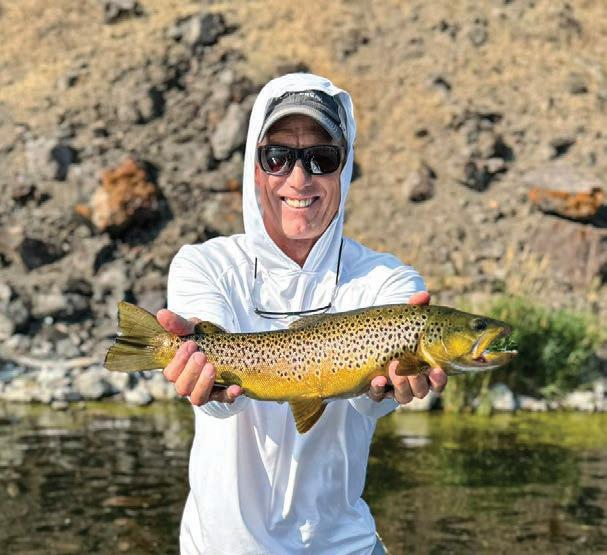




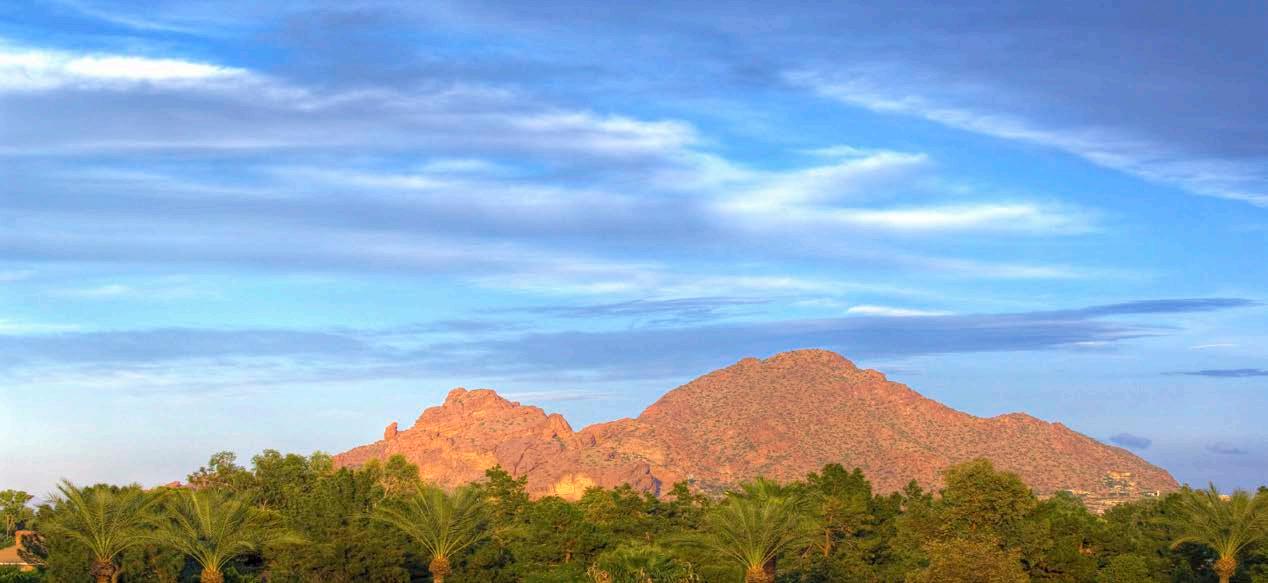













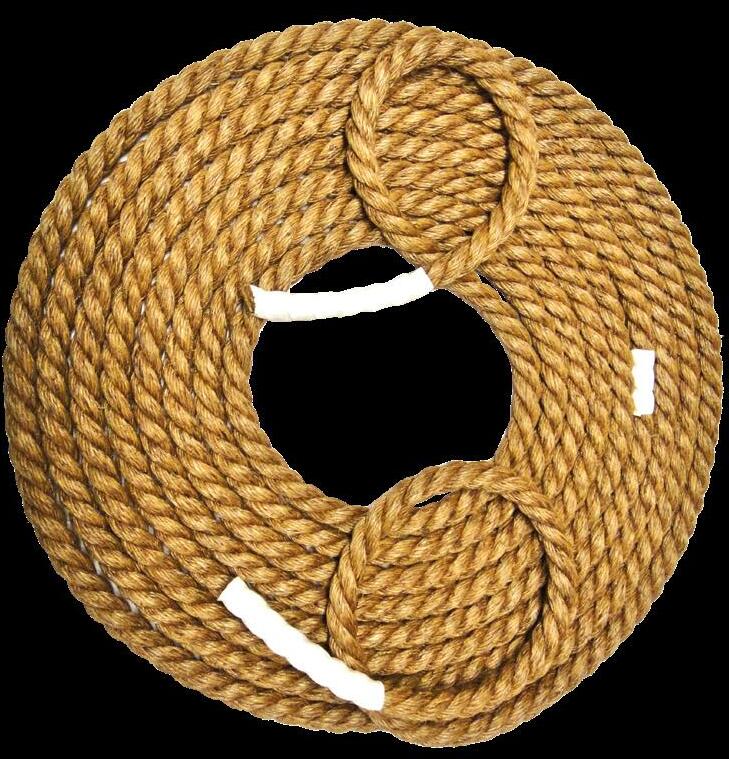












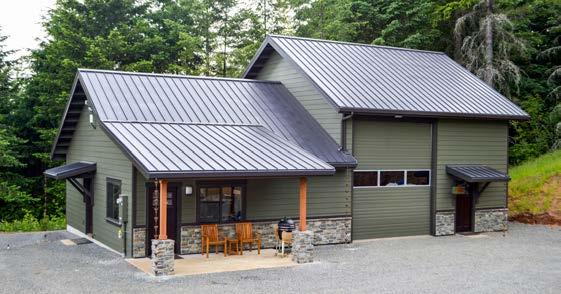






GRIZZLY BEAR
BOOK EXCERPT: FORMER CAL QB
FACES BLITZING ALASKAN BRUIN
When in 2014 we last profiled Mike Pawlawski, a former star college quarterback for the California Golden Bears, he’d already made quite a journey in his life. From having lung and breathing issues as a Southern California kid and overcoming more high-profile recruits to his standout turn in college, to a long Arena Football League career, hosting outdoor TV shows and now plying his trade as a motivational speaker, that’s quite the compelling resume. Pawlawski is eager to share the highs and lows of his own experience and pass on what he’s learned to others via a new book.

“I think today, everybody is talking about hacks and shortcuts, and all these things that you can do. Everybody thinks there’s a magic pill that you can take, and all of a sudden you’re successful. And unfortunately, marketing does that because human nature wants that if they can find it,” Pawlawski says. “So from the perspective of someone who’s done it in sports and business and in life, I thought it would be a big thing to get it out there for people to understand that there’s really a process, and the process is the same no matter which field you’re in.”
Via the series Familiar Waters and Gridiron Outdoors, he chronicled fishing and hunting adventures throughout North America and beyond, including a Northern California pig hunting trip with fellow Cal quarterback alum and current Detroit Lions star Jared Goff (California Sportsman, April 2016).
But one of the book’s a-ha moments was an encounter while filming unaired footage of bears in Alaska’s Bristol Bay region. “When I first started writing the book, I’m like, ‘I don’t know if I have enough stories.’ Because I am a storyteller; that’s part of what we do. I enjoy that. Stories are the way we encode lessons to the human brain,” he says.

“And I started going through my stories and I was talking about the biology of fear and I thought, ‘Oh, the grizzly. That’s the story.’ But it’s a very poignant story. You don’t go toe to toe with a griz every day.”
Call it the Golden Bear versus the grizzly bear. The following is excerpted with permission from Every Day Great: The Playbook For Winning At Everything, by Mike Pawlawski and self-published by the author.
“If you are distressed by anything external, the pain is not due to the thing itself, but to your estimate of it; and this you have the power to revoke at any moment.” –Marcus Aurelius
By Mike Pawlawski
August in Southwestern Alaska is a transitional month. The skies are mostly gray with intermittent rain as Old Man Winter hints at his approach.
The streams and rivers dissecting the tundra change color from their glacial green to take on a red hue, reflecting the glorious color of salmon that choke their banks on the annual upriver migration. Sockeye first, then kings, chum/dog and coho fill the inland waters, bringing nutrients back from the sea to deposit, either as dead flesh or in the form of poop from bears, eagles, wolves, and any other predators or scavengers that make a meal out of the returning bounty.
Salmon are a cornerstone species in the cycle of life on the Alaskan tundra. They are retrievers that go to the sea to fatten up and bring much-needed nutrients back to an uncivilized and harsh wilderness that would otherwise be barren and lacking in nutrients to support all but the simplest foliage.
Moraine Creek is in Katmai National Park. It used to go by the name “Bear Creek,” which is what guides and fishermen name a river in Alaska when they’re trying to keep other guides and fishermen away. In this case, the name was appropriate. Moraine Creek gets a phenomenal run of sockeye salmon, and the word is out among local grizzlies. According to an Alaska Department of Fish and Game officer I interviewed, bears come from miles around to enjoy the feast. Many even make the journey all the way from the coast.
I’m here producing a documentary on an ill-advised copper mine a Canadian company is developing near Lake Iliamna (the Pebble Mine). Copper mining in such a fragile ecosystem threatens the wildlife that
count on the annual salmon runs to survive. The smallest incursion of copper to a river can wreak havoc with the salmon’s navigational system, making it unlikely that they will find and return to their native spawning grounds. There’s potential for great harm if the people of Alaska aren’t extremely careful.
Float planes have helped tame the Alaskan wilderness. On our final approach, we came in low and hot over the creek, so close to the water you could see individual fish. Today, our pilot is Brian Kraft, a classic Alaskan bush pilot and owner of the Alaskan Sportsman’s Lodge, one of the finest lodges in Southwestern Alaska. Not only does Brian fly and operate the lodge, but he also played minor league hockey back in the day and has the swagger to show for it.
“Look at that!” Brian said in a tinny voice coming through my airplane headset. “Red gold!”
Many of the stretches were so full of sockeye it seemed there were more fish than water. That kind of bounty, especially in a place as wild as Alaska, always brings out predators. Along
the banks, either hard at work or jockeying for position, we saw several dozen bruins using various fishing methods to fill their plates.
After a final pass to check wind direction, we landed, unloaded and proceeded to film bears for two hours. At times, I was so close to grizzlies going about their business I could smell them. The footage would add a lot to my documentary. We came to film bears, so now we could take our time on the float out because the planes were meeting us 7 miles downstream on Kukaklek Lake.
As I headed back to meet up with our guide, whom I will call Fletch, and my cameraman, Bill, I rounded the top of the island serving as my filming station for the morning and came face to face with two young grizzlies heading the opposite direction, a male and female from what I could gather. If I had to guess, they were twins. The male stood 3.5 feet minimum at the shoulder. The female was slightly smaller and had a narrower face.
I’d been in close proximity to bears all morning. I’d grown comfortable, though not complacent, toward the

As Mike Pawlawski took a star college football turn as the Cal Golden Bears quarterback in the early 1990s, the story of his younger days went mostly untold.
“I don’t think anyone talked about it, right? It was ‘behind me’ because I had beat it at that point,” Pawlawski says of the lack of media attention on a childhood condition he overcame before leading the Golden Bears to one of the program’s best seasons ever as a senior in 1991. Cal went 10-2 and finished in the top 10 of the final national rankings.
Pawlawski would also go on to a successful Arena Football League career capped off with a 1999 league championship. But as a kid growing up in Southern California’s Orange County, he was in and out of hospital rooms and doctor’s offices.
He was born with what would be for a long time an undetected lung condition that made it difficult to breathe. Years later after he finished his college career, a doctor confirmed that he’d suffered from cystic fibrosis, but that diagnosis was inconclusive over several tests as a youngster in his hometown of Fullerton.
Still, athletically he found a way to excel at a variety of sports and activities.
“When I wasn’t sick and in the hospital … I was good on my Little League baseball team and I used to play and practice with my brother’s soccer team when I was too young to be signed up,” Pawlawski says. “I played basketball, I swam; there was all kinds of stuff my parents put me into. I used to go Boogie Boarding at the beach. I always excelled athletically.”
As he wrote extensively in his new book about those childhood sick days, they triggered some traumatic memories. Even as a football career at Fullerton’s Troy High School resulted in a scholarship to Cal, where he became one of the school’s winningest quarterbacks, it wasn’t easy.
“Even when I was a kid and was running my lungs would burn and it would be difficult. But I was pushing through it. That didn’t just stop. It was always a little harder for me in conditioning than everybody else. Because I still had the traits of cystic fibrosis and adapted to
overcome that,” Pawlawski says.
“And that’s the point of the book. You push through the suck, and if you understand what’s going on with your nervous system, then you’re able to do that. Now you can adapt, which is your superpower.”
Now 55, Pawlawski has kept busy following his playing days, hosting two shows on Outdoor Network. He’s a motivational speaker and his alma mater’s analyst on Cal’s football radio broadcast. When asked if he’s overachieved to get here, Pawlawski thinks it’s up to others to determine that.
“From the doctors who saw me when I was a kid and the people who saw me as a sickly kid, they probably think I overachieved. But it’s all about your belief structure and if you believe that you can accomplish it and are willing to put in the effort and adapt, then you’re not overachieving,” he says. “You’re just maximizing your human potential. That’s the thing that people need to remember; we’re going to adapt as long as we’re willing to push against resistance if we’re willing to face the tough times.” -Chris Cocoles


end. I wasn’t worried about this encounter. They headed to the creek to fish, and I just happened to cross their path at the wrong time. I stopped for a second and held my ground, and
they veered left into the island brush. They looked a little annoyed but left me alone.
No harm done, I continued downstream, wading in shallow
water on the left side of the island. The island was about 200 yards long. The bottom of the island created a shallow gravel bar that allowed access to the left bank where our raft was beached. About three minutes after my first encounter and just short of reaching the bar, I heard a ruckus in the woods. Suddenly, the two young bears I’d bumped earlier came crashing out of the brush 15 yards in front of me to my right.
On my left was deep water. On my right the island was nearly impenetrable for a human. I was trapped between a lake and a very hard place. They froze and I froze. We locked eyes. They looked panicked.
I could relate.
Bill, who had a higher vantage point, told me later a bigger bear had chased them off his fishing grounds and back into the woods. It just wasn’t their day. They were scared and nervous, and so was I. Once again, I was standing in their way.
I stood my ground again, putting my camera and tripod in front of me as if it would shield me from a







“The saying is, ‘Be the bigger bear.’ Sounds good when you’re at the lodge in front of the fire sipping whiskey. Everybody has big balls in the lodge,” the author writes. “Outdoorsmen, in particular, love to tell stories of their bravado. Like most things, though, when the bear scat hits the fan, it’s a little tougher to execute.” (MIKE PAWLAWSKI)
bear attack. They hesitated, and I saw them weighing their options. The male considered coming right through me. His sister, though, being a good girl, quickly decided to hug the bank on my right and skirt past me. She tucked her tail and looked away, a sign of submissiveness in the animal kingdom, as she snuck through the gap 7 yards to my right. But now I had one bear in front of me and one behind. I couldn’t watch both.
The technical term for that is “no bueno!”
THE MALE HADN’T MADE up his mind about his next move. His posture was notably more aggressive. He stared at me, agitated, and swayed side to side on his front paws as a third bear appeared on the bank to my left. From the look of things, this was momma. She was bigger and fatter and seemed to carry authority. She surveyed the situation, made a low grumbling noise, and turned away. The young female ran to her while
the male jumped in the water to my left and swam across to where she was heading.
“Holy shit,” I thought, as I suddenly realized I’d stopped breathing.
It’s fascinating how that happens. It was the thing that got me through my illness as a kid. It may have been slow or labored, it might have been difficult, but I never stopped breathing; breath is life, and when you’re breathing, you’re in the game.
“Breathe,” I thought as I took a deep breath. Then, I gathered myself and finished my walk downriver to the raft.
It was a great bear encounter. A story I could tell at parties for the rest of my life. The day I stared down two “griz” in the wilds of Alaska. One more amazing tale from my time spent in the wild.
Challenge accepted!
About a mile downriver sitting at lunch, we recounted the run-in as we laughed and ate like kings. Fletch cooked up salmon and rice with
before caught up with us. They began fishing just below our vantage point on a cliff promontory overlooking the river. They put on a show for the camera. They fished for half an hour before heading into the streamside brush 50 yards from our perch.
That’s when Bill asked Fletch, “How can you tell when a bear is pissed?”
Fletch responded, “They chuff and chomp their teeth, like this.” He proceeded to mimic a bear’s challenge verbalization, “Chuff! Chuff! Chomp,” making a reasonable impression of a ticked-off bear as he popped his teeth and gutturally grunted.
I’m no bear expert, but it must have been a pretty good impression because the young bear burst out of the brush 30 yards upstream.
And he was pissed! Oblivious to what was happening, Bill mimicked Fletch, and the bear heard it.
“Hey! Knock it off!” I said as I
2.8L












for the adventures

the opportunities
“From the doctors who saw me when I was a kid and the people who saw me as a sickly kid, they probably think I overachieved,” he admits. “But it’s all about your belief structure, and if you believe that you can accomplish it and are willing to put in the effort and adapt, then you’re not overachieving.”
pointed at the young bear bearing down on us. “He’s pissed! And he’s heading our way.”
The reason I didn’t back down for our first two encounters is because you’re supposed to stand your ground versus a grizzly. If he intends to eat you, you’re screwed anyway. Griz can run 35 miles an hour in short bursts, and they can rag-doll you with one swipe of their massive paw. If you run, you become prey in their mind, and they’ll catch you.
But … and it’s a big but … if a bear is being defensive or territorial and you stand your ground, you stand a chance of winning the bluff game.
The saying is, “Be the bigger bear.” Sounds good when you’re at the lodge in front of the fire sipping whiskey. Everybody has big balls in the lodge. Outdoorsmen, in particular, love to tell stories of their bravado. Like most things, though, when the bear scat hits the fan, it’s a little tougher to execute.
This bear was closing fast. He was done with our tomfoolery, and he was gonna let us know. Soaking wet and glistening, he closed to within 20 yards. Head lowered and shoulders
back, he was on a mission. He’d been challenged and was going to show us he was up to it.
He came to a stop and stood upright on his hind legs. We gasped.
Though he was young, this SOB looked massive.
“He couldn’t be any more intimidating,” I thought. Little did I know I was wrong.
Apparently, Bill didn’t get the memo about standing your ground. Seeing that bear at full height was too much for him. Our situation went from scary to a direct threat in Bill’s mind at that moment. Even though my full attention was focused on the bear, I couldn’t miss Bill’s escape as I saw him shoot past the camera from left to right and down toward the raft.
among fishing guides: Two fishermen are standing on a river, and they spot an angry grizzly approaching. Immediately, one fisherman starts putting on his running shoes. The other fisherman looks at him and says, “What the hell are you doing? You’re never gonna outrun that bear.” The first fisherman
looks up as he finishes tying his second shoe and replies, “Nope. But I am gonna outrun you!”
Bill was the first one out of the blocks. Smart. Just in front of me, on my right, and closer to the raft, Fletch was still hanging in there. His identity as a hardy Alaskan guide would be seriously challenged if he ran first.
The bear had breached that invisible barrier, where all wildlife encounters feel too close, as he dropped to all four and chuffed. “Chuff! Chuff!” We could almost feel his intention, chomping his teeth. “Snap! Snap!” He was looking to intimidate us.
It was working!
My nervous system was at DEFCON 1. Heart pounding and drymouthed, I knew my waders were waterproof from the outside, but I was about to test out whether they worked versus an internal leak.
My stomach had bats, not butterflies, and my jaw felt as tight as a snare drum. My breath came shallow and choppy, and I could feel the weight of the world on my chest as the blood pulsated through my ears. My face was hot and flushed, but I could feel the cool breeze across my skin. My body was screaming to do something!
He looked massive and soaking wet. Somehow, that made him look way more menacing. Sister and Mom were nowhere in sight, and he was clearly pissed!
Almost in unison, something triggered Fletcher and I. “Go on, bear!” we commanded, trying to bluff like we were in charge.
The bear wasn’t having it. He chuffed again, “Chuff! Chuff!” and then gnashed his teeth and scowled. His version, I assume, of “Go on, humans!”
Somehow, the intensity ratcheted up, and Fletcher and I once again repeated, “Go on, bear!” as we put our arms in the air to look big.
This was a standoff.
The bear chuffed again, “Chuff!” and snapped his jaw.
That’s when Fletch reached his breaking point. The stand-yourground thing wasn’t working for him anymore either, so he bailed off the rock down to the raft 10 yards to our
right. Not much of a retreat but out of the line of fire.
I couldn’t blame him and probably would have done the same if I thought I had a chance. But I knew turning my back and running down the trail to the raft below at this point would immediately make me seem like prey in this bear’s mind, and he would be on my ass in a blink with gravity and a full head of steam to assist him. There was no chance he would stop. Whether he wanted to eat me or just mess me up, it would happen at the bottom of that trail if I turned and ran at this point.
The bear noted Fletch’s escape and then looked back at me as if to say, “It’s just me and you now, buddy!”
I exhaled and thought, “Well hell! Now what?”
The thought crossed my mind, “At least the camera’s rolling so my son, Casey, can sell this as a viral video when this bastard eats me.” Then, sickly, I chuckled.
As if the bear could hear my inner thoughts, he lowered his front
shoulders and dropped his head to assume a charging posture. That move made it very real for me. If I had a gun, I would have emptied it into this bear at that moment. But we were in Katmai National Park. It’s a federal preserve. No guns allowed. I was trapped.
This was crazy!
THIS WAS THE FIRST time I stood toeto-toe with a challenging grizzly, but the feelings were somehow familiar. Fear is fear, whether it’s a griz or a game. Your nervous system doesn’t differentiate. I felt it on the sideline at Cal when I was sure I couldn’t play and before that as I lay separated from my parents inside the oxygen tent as a sickly kid. It was the same feeling in the tunnel before every game, the Alaskan Outback, and the pediatric ICU. It had a name. It was my stress response, and it was on blast.
“What the hell am I doing here?” the nasty little voice screamed inside my head, looking to blame someone. I shifted my weight, and gravel
crunched under my wading boots as the low sound of the ancient river to my rear mixed with the whirring of wind across the tundra. Like a classic Hollywood Western, it punctuated the moment. I felt like I witnessed the moment in slow motion rather than experienced it.
A morbid curiosity about what would happen next crept into my mind as I tried one last time.
“Go on, bear! Git!” I yelled louder, still without the courage of my conviction. Then our eyes met, and time froze.
Something changed.
He snarled.
I drew a sharp breath.
Then everything went silent, and he charged! CS
Editor’s note: Order Mike Pawlawski’s book, Every Day Great: The Playbook For Winning At Everything, at amazon. com/Every-Day-Great-PlaybookEverything-ebook/dp/B0DHPRKFV3 Follow the author on Instagram (@ mikepawlawskicoach).






By Cal Kellogg
It was probably the fall of 1974 or ’75 when I was around 7 years old, but I remember the day vividly. Even at that young age, I was an avid outdoorsman who accompanied my dad and Uncle Bob on frequent hunting and fishing adventures.
I’d heard the grown-ups talk about California’s wild turkeys with fascination, as if they were pondering
something as exotic and elusive as a cougar or grizzly, but up to that point no one in our circle had ever seen one.
Dad, Bob and I had spent the weekend deer hunting in Northern California near Paynes Creek in Tehama County. We were in the process of driving home on Highway 36 when Dad caught sight of two wild turkeys standing in a clearing on the far side of the road.
Dad pulled the Toyota pickup to a
stop beside the road and the three of us stared at the hens in amazement. The stories we’d heard were true; turkeys did roam the wildlands of Northern California!
Fast forward 10 years and spotting wild turkeys had become a regular part of our annual deer hunts in Tehama County. I recall one afternoon in particular when more than 60 hens walked past my dad and I as we sat in a tree stand.

The point of all this is that the turkey population expanded so quickly in a decade that seeing them went from being notable to commonplace. Over the past 30 years the California turkey population has steadily expanded and evolved. In some areas, turkeys are so plentiful they’ve become a nuisance to farmers and homeowners. There are other locations where turkeys have only shown up recently.
I have a friend living in far Northeastern California, where the forest environment transitions to desert. He isn’t a hunter, but one day while we were catching up on
the phone he reported that there were three gobblers standing in his driveway.
Because that proclamation naturally caught my attention, I pressed him for details. Long story short: He’d never seen turkeys in his area until three years ago; now they are semi-regular visitors to his property. I haven’t hunted there yet, but the area is on my to-do list come spring!
Attempts to introduce turkeys to California date back to 1877. All of
the early releases, including stocking domestic birds and wild birds from Mexico, failed for a variety of reasons.
It wasn’t until 1959, when the California Department of Fish and Game (now CDFW) released 62 wild Rio Grande turkeys imported from Texas, that a successful population was established in San Diego County.
Throughout the 1960s, ’70s and ’80s, the state continued planting turkeys in various areas of California and relocating problem turkeys to new habitats.
Today, there are nearly 250,000 wild turkeys residing in the state. Most of them are Rio Grandes, but Merriam’s turkeys also exist. The Rio Grande was thought to be mostly a valley and foothill dweller, while Merriam’s tend to live at higher elevations. Merriam’s turkeys were introduced with the idea of establishing a turkey population in the middle elevation portion of the Sierra.
According to CDFW, wild turkey populations are now firmly established in the lower-elevation oak woodlands of both the Sierra and Coast Ranges, along the NorCal coast throughout Mendocino County, along the central and southern coastal areas all the way to San Diego County, and to the far north in both the Klamath and Cascade foothills.
All the known areas of turkey habitation listed above are good areas to pursue turkeys in fall and spring. Hunting these areas is nothing new, but areas where the turkey population has expanded and continues to expand are of special interest to me.
It stands to reason that areas where the population is expanding will have less hunting pressure than regions that have traditionally held turkeys. I find it very exciting to hunt uneducated birds few hunters know exist!
While CDFW has no data they’re willing to share, there is plenty of anecdotal evidence of the turkey population expanding eastward. There

are enough stories and photographs online to confirm wild turkeys are making a push into the eastern reaches of far Northern California – say, from Sierra County northward to the Oregon border. These areas have small human populations, lots of public land and are ripe for exploration by adventurous turkey hunters.
I live in the north-central Sierra outside of Auburn. Being an avid turkey hunter I make it my business to keep tabs on the turkey population. Twenty-five years ago, the vast majority of the huntable turkey population in my area was confined to the oak woodlands of the San Joaquin-Sacramento Valley and the Sierra foothills. Since then, I’ve watched the population steadily seep eastward into higher-elevation areas.
Several years ago while deer hunting, I came upon a concentration of turkey sign in the Tahoe National Forest at about 4,700 feet in elevation.
This is far higher than I’d ever seen Rio Grande turkeys, so I was hopeful I’d found a pocket of Merriam’s turkeys. I’ve never harvested a Merriam’s, and I thought the chance to bag one had fallen into my lap.
In spring I worked the area hard for the first few days of the season without results. When a cold spring storm moved in and dropped a few inches of snow, I was ready to give up on the area, but I decided to give it one last try before moving lower. That’s when I found a lone turkey track in the snow while walking an overgrown logging road.
The next day, I was standing in the chilly woods before dawn near where I’d seen the track. When I heard a gobble a few hundred yards up the ridge, I moved fast to close ground before the bird or birds flew off the roost.
When I figured I was close enough I settled in, made some hen noises and
the gobbler answered. Forty minutes later I was standing over a really nice 2-year-old Rio Grande gobbler with a 9-inch beard.
Rios weren’t supposed to venture up that high in elevation. I inspected the bird closely for any tell-tale signs that it was a Merriam’s hybrid, but as near as I could tell it was a 100-percent Rio Grande turkey.
Since then, I’ve seen other Rio Grandes up above 4,000 feet. My personal belief is that the birds are beginning to adapt and expand into higher-elevation habitats. Turkeys are generalists in terms of their diet, and it is very possible they have identified food sources at higher elevations that sustain them.
I’m also convinced that the birds I find up at higher elevations are migratory and drop down to areas below the snow line during the winter, then climb back up in elevation as winter gives way to spring.
Moving on, there is a huge population of turkeys in the Sacramento Valley and throughout the Bay Area and surrounding area. I’ve even seen huge gobblers feeding along the shoreline of San Francisco Bay in the Berkeley Marina, where they look oddly out of place.
Certainly, there are places in the Bay Area and near Sacramento where you could safely hunt turkeys.
The problem is that there is very little public land in these areas that allow hunting. The trick to get at these birds would be to find a private landowner who would give you access.
Of course, gaining access is a tough mountain to climb, but not impossible. Not everyone is thrilled with having turkeys around their property, standing atop their expensive cars and scratching them or peeling back lush green turf as they look for worms and other goodies.
I would think if you were hunting with a bow or airgun as opposed to a shotgun, it would help your cause infinitely.
California turkey hunters can consider themselves lucky because
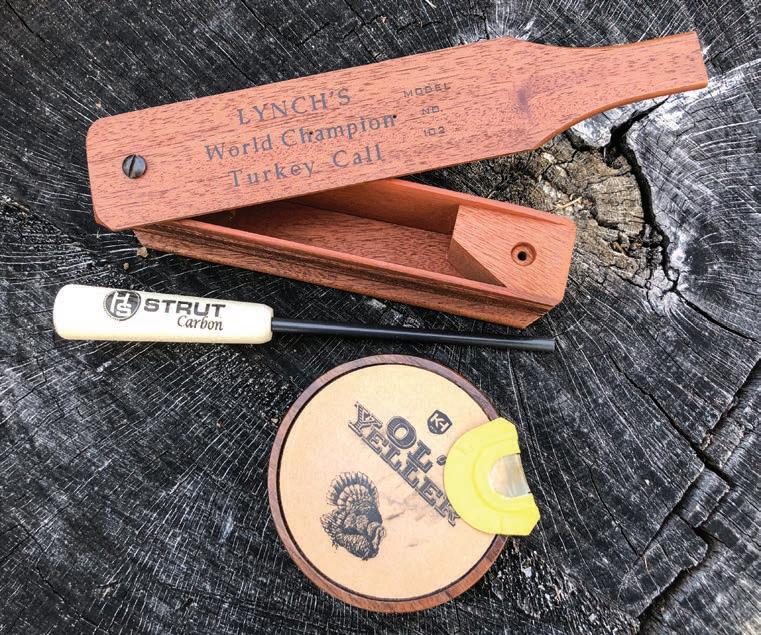
we have a fall turkey season. There are some states that only offer spring hunting. To be sure, the spring season is more glamorous than fall hunting. And one of the cool things about the fall season is that it’s an either-sex hunt. Hens, gobblers, jakes and jills are all fair game during the fall.

Calling a 15- to 20-pound lovesick tom within range is indeed an apex experience, but fall hunting is also challenging and satisfying. While calling is an important part of spring turkey hunting success, it’s mostly woodsmanship that puts birds in the roaster during the fall.
Scouting and covering ground are the key features of fall success. While scouting you don’t actually have to see turkeys. During daylight hours, tracks, droppings and the odd shed feather all betray the presence of turkeys.
Early and late in the day, you can also stand a listening post on a prominent high point and listen for birds. When the turkeys go to roost in the evening and come off the roost in the morning, they tend to get very excited. Hens yelp as loudly as toms, but toms gobble too. Gobbling just isn’t a vocalization made during the mating season.
If you are lucky enough to hear gobbling in the fall, you may have really hit the jackpot. Harvesting a mature gobbler in the fall is quite an achievement. During the fall and winter, gobblers often form into bachelor groups. When you hear


gobbles at this time of the year, there are likely multiple toms traveling together.
IT’S YOUR CALL
Getting within range of jumpy gobbler during the spring can be tough, but getting within range of a group of fall toms without the edge calling provides is indeed a challenge. I’ve taken dozens of fall turkeys, but only one of them has been a mature gobbler.
Once I locate an area that is holding fall turkeys, ambush hunting has proven to be the best tactic for
“California
“There are
me most days. Turkeys don’t like to move through thick woods, so old roads and firebreaks are good spots to set up for a long wait. Just make sure your hide is comfortable and within shooting range of the spot you expect the birds to travel through.
While waiting, feel free to make a few light yelps, but don’t try to do too much. Two or three light yelps every 20 to 30 minutes are plenty. And you must sit still. If you can’t sit still for a long period of time, your chances of success decline sharply.
On rainy days turkeys will still feed, but they also spend extended periods of time standing under the shelter of trees waiting out the showers. If you want to still hunt and sneak within range of a bird, the best time to do it is on a rainy afternoon. When the birds come off the roost, they will move and feed for a few hours in all but the heaviest rain. By the time the afternoon rolls around, they’ve eaten and are content to spend their time huddled under trees trying to stay as dry as possible.
Since fall turkeys tend to travel in groups, be they groups of hens or bachelor groups of gobblers, chances are the birds will detect you before you actually get off a shot. That means you’ve got to be prepared to cut down a moving bird at longer average distances than during the spring, when you are able to call a lone gobbler close to your location.
During the spring, I often utilize magnum 12-gauge shells loaded with No. 7½ tungsten shot in order to deliver as many hits as possible to a gobbler’s head and neck at close range. Heavier No. 4 or 5 shot is a better choice during the fall since the large shot hits harder and penetrates better at longer range.
Steel shot will certainly kill a turkey, but at longer ranges tungsten shot will kill birds faster and more reliably.
The most successful turkey hunters are the folks who think turkey hunting all year long. One of the overlooked attributes of fall hunting is that the season gives you an opportunity to locate areas holding birds. Those same areas are a good starting point for your spring hunting adventures.
Good luck, get out in the field, read the sign and drop the hammer on a Golden State turkey this fall! CS
Editor’s note: California’s fall turkey season runs from November 9 through December 8. Cal Kellogg is a longtime Northern California outdoors writer. Subscribe to his YouTube channel Fish Hunt Shoot Productions at youtube.com/ user/KelloggOutdoors.

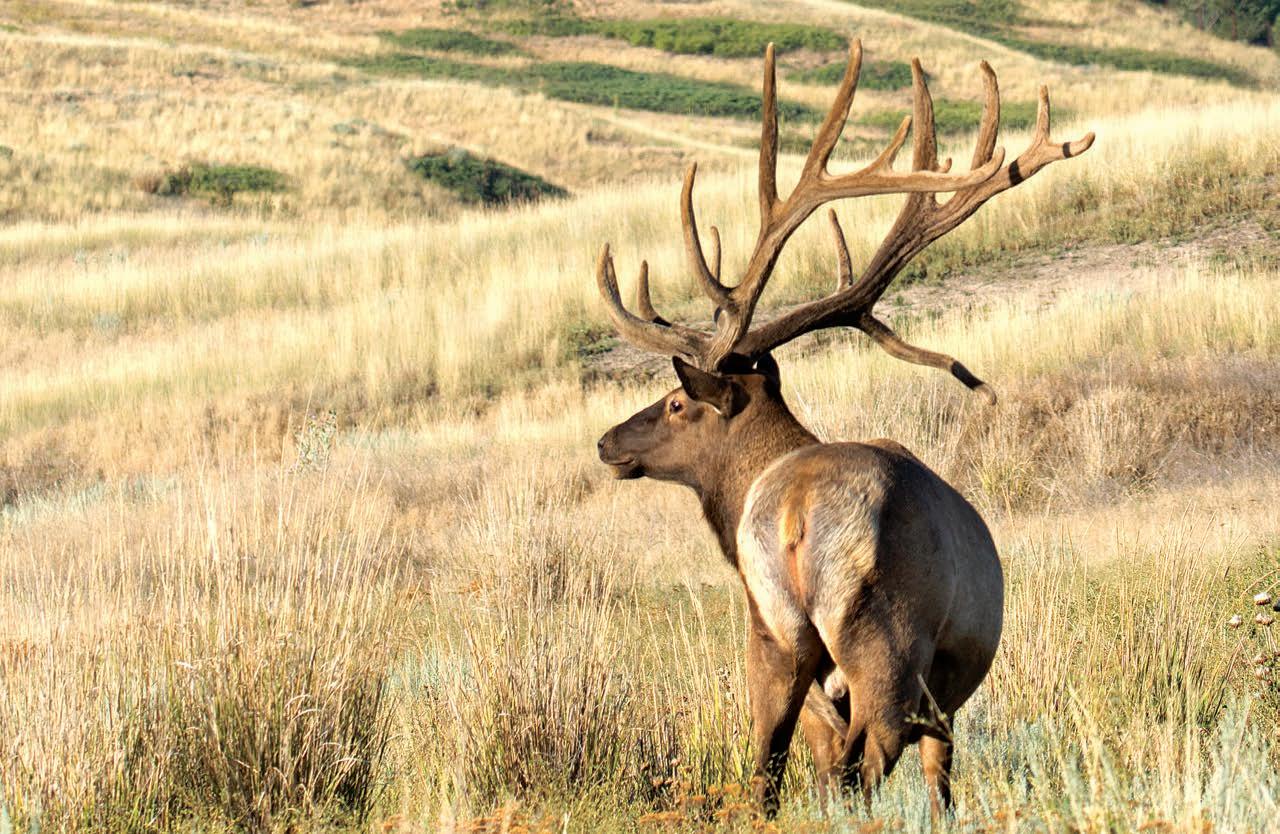






By Scott Haugen
Last season I had some fantastic duck hunts I wouldn’t have experienced were it not for cellular trail cameras. The immediate intel they relayed was invaluable. The fact I was prepared, and flexible, played a big part in the success too.
The first hunt came when warm weather hit our area. It caused rye grass to flourish and that attracted wigeons, as it does every season. But we had a lot of rain and ducks were
spread throughout several square miles of the valley.
One Wednesday, I walked to a blind on a series of farm ponds I hunt a couple times a week. The green grass was 6 inches tall. I returned on Saturday and it had been mowed to the mud. Wigeon droppings and tracks told the story.
I set two cellular trail cameras on the grazed grass. Eleven days later when the grass was 4 inches high, the little lawn mowers returned. The next morning I had three dozen Big
Al’s wigeon silhouette decoys set smack in front of the trail camera where the wigeon had been working. Twenty minutes into the hunt I was done with a wigeon limit in hand.
I’d set the silhouette decoys in a tight group, simulating what I saw on the trail camera video clips. I run Moultrie Mobile Edge Pro cellular trail cameras, all on video mode. A 15-second high-definition video clip reveals sights and sounds that still images never will. We had more great wigeon hunts last season, thanks to

By Tiffany Haugen
Igrew up in filbert country – what many folks call hazelnuts. Today, filbert farming has expanded. With that has come an increasing number of wood ducks and mallards overwintering to feast on the fine morsels; yes; mallards love gobbling down filberts.
Last season Scott brought home a limit of mallards; their expanded esophaguses –ducks don’t have crops – were loaded with filberts; one drake had over 30 whole nuts in there. Ducks swallow filberts whole, and they’re then passed into the gizzard where they’re ground into tiny pieces for more complete digestion.
I took them out of the esophaguses, rinsed, cracked and ground them to use in this recipe. If that’s a bit much, or you don’t have ducks in your hunting area that feast on filberts, consider getting some of the nuts from the store for the sole purpose of
this recipe. It’s worth it; trust me.
We’re a fan of eating ducks fresh, as freezing imparts a gamey taste. But this recipe works well either way. Just make sure all bloodshot and wound channels are clean prior to cooking.
1 pound duck breasts
½ cup ground filberts
½ cup panko (breadcrumbs)
¾ teaspoon salt
½ teaspoon pepper
1 to 2 tablespoons finely chopped fresh parsley
2 tablespoons mayonnaise
1 tablespoon mustard
1 tablespoon honey
2 tablespoons butter
2 tablespoons olive oil
Clean duck breasts and remove tenderloins to use in another recipe; think stir-fry. Cut larger breasts in half. Pound out breast
meat between sheets of waxed paper to ¼-inch thickness.
In a medium bowl, whisk mayonnaise, mustard and honey until thoroughly combined. Add duck breasts and marinate for 10 to 15 minutes. In a shallow bowl, mix ground hazelnuts, panko, salt, pepper and parsley until combined.
Heat butter and olive oil in a skillet on medium-high heat. Remove duck breast from mayonnaise mixture and coat with nut mixture on both sides. Place in a hot pan and repeat with remaining breasts. Cook for two to three minutes on each side or until golden brown. Do not overcook or the meat will be tough and have a gamey taste. Garnish with fresh parsley if desired.
Editor’s note: For signed copies of Tiffany’s popular book, Cooking Game Birds and other best-selling titles, visit scotthaugen.com.



cellular trail cameras.
Buddies and I had two solid hunts on creeks because of the devices. One was for mallards. A creek was recovering from a week of high water. The slow-flowing stream was attractive
to mallards. At first, there were only a dozen birds using it, which is when the trail camera went up.
It took just over a week for mallard numbers to build, and when they did, three of us tossed out a dozen decoys

and had three limits in less than 45 minutes. The shooting was close. I killed my limit using a .410.
I love decoying wood ducks and when a small stream swelled with high water, woodies piled into it. I put up a trail camera and got footage of ducks swimming into brush that’s normally surrounded by dry land. The high water created a wide section in the creek and that’s where a six-pack of Final Approach Live Wood Duck decoys were set well before daylight. I had a great hunt that morning.
Timing is one of the key benefits cellular trail cameras convey. Last January, as water dropped in a series of farm ponds I like to hunt, ducks started roosting on exposed strips of land. Wigeon, pintail, greenwing teal and mallards all congregated there. They started showing up around 10 a.m. and stuck around for three or four hours. Trail cameras captured a huge burst of bird numbers in





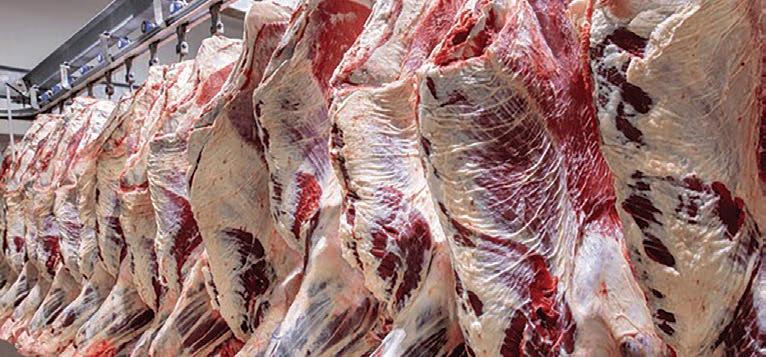



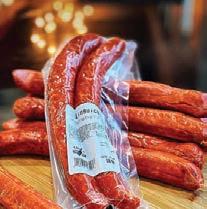






Looking for more awesome tools to help improve your comfort and success this waterfowl season? Try these. I have and will keep using them this season, and the next.
The Heyday Bare Strap is an ingenious, versatile tote that not only works on ducks, but I used it on ptarmigan in Alaska, doves, quail, grouse and more. Their HydroLeather strap and coated steel cable makes one of the most effective, secure and easy-touse bird straps I’ve seen. Get the Full Kit, as there’s a use for every bit of it. MSRP: $70; info: heydayoutdoor.com.
I’m not a very good duck caller, which is why I rely on Slayer Calls; they make me sound good. One I used a lot the last two seasons is their Whistler’s Mother ($50), which produces crisp, loud wigeon whistles, precise wood duck sounds and drake mallard chatter that appeals to all ducks. It’s loud, making it ideal on rainy, windy days. I also love their single-reed Ranger ($135) for the range of sounds and volume it creates. This season I look forward to using their Dubar ($135) tooth-like notched call that had duck hunters talking like crazy late last season. Slayer’s calls are simple, easy to use and work; that’s what I need. Info: slayercalls.com.
Yeti’s new Wetlands Collection has caught the attention of many waterfowlers this fall, including me. I love the earth-tone look of the two Ramblers and they keep my coffee hot for hours. The Loadout GoBox 60 Gear Case is perfect for the blind and the duck boat. The latch is sturdy and crisp, and the tray easy to remove; it’s very applicable for what we do. Info: yeti.com. SH

one particular spot when the wind blew hard from the south. The winds were supposed to be the same the following day, so that’s when I planned to hunt it.
It wasn’t easy sleeping in and heading to the duck blind until 9 a.m. A buddy joined me; he felt the same way. We packed five dozen Big Al’s silhouette wigeon, mallard and pintail decoys on the narrow strip of land and plopped a dozen floaters near them. We mimicked the look the trail camera had revealed. We didn’t see a single duck until nearly 11 a.m., but once they started showing up, the action was nonstop. We were done in under 15 minutes.
Three days later we hunted another spot where my Moultrie Mobile trail cameras captured mallards coming to a flooded corner of a farm field. One camera even caught them perched on a fallen dead cottonwood tree. The grass was tall and the water a foot deep on the edge, so we hunted from MOmarsh Invisi-Man blinds.
My friend tossed out six floating mallard decoys while I secured a dozen Big Al’s mallard silhouettes I’d equipped with garden stakes so they could be quickly pounded into the fallen cottonwood tree. With flat mallards perched on the limbs and a few floaters in the shallow water surrounding them, we emulated what the cellular trail camera showed. We shot limits as birds trickled into our little setup that morning.
Sometimes water levels and wind direction force food to shift in a matter of hours, meaning the window in which to hunt is narrow. But thanks to cellular trail cameras, buddies and I had some outstanding hunts last season.
We’re already looking ahead to this season, and we have more blinds and decoys ready to roll when the trail cams reveal where to go, when. CS
Editor’s note: To order signed copies of Scott Haugen’s best selling books, visit scotthaugen.com. Follow Scott on Instagram.

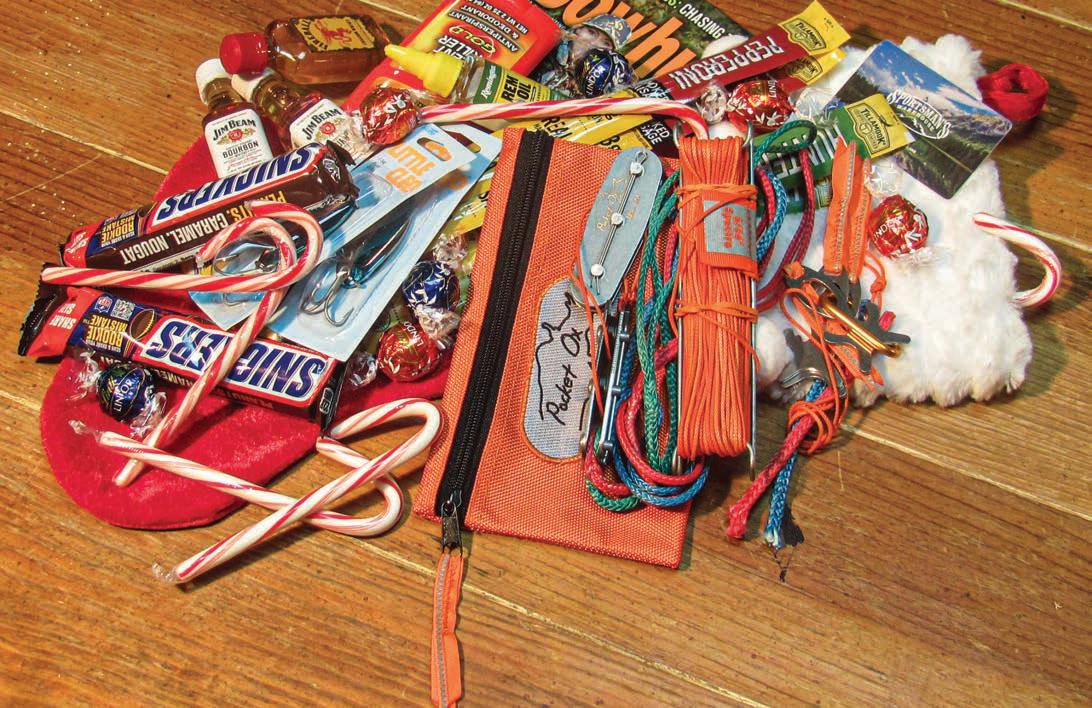


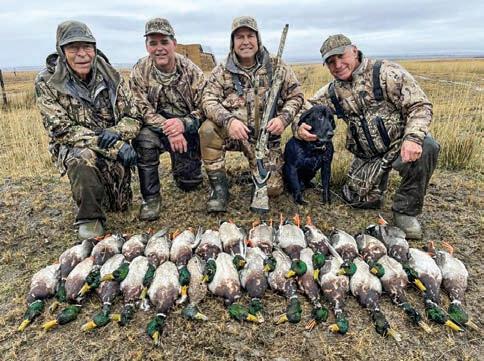








By Mark Fong
You might ask the question, “What does a fishing guide do in the offseason?”
The answer is that he goes hunting, of course. In the case of Dakota Townley, he does more than simply hunt; he leads guided goose hunts for Blosser Outfitters.
Townley is a member of the four-man guide team employed by Blosser Outfitters. Tomas Blosser, the principal operator, is headquartered in the Sacramento Valley community of Willows. Blosser has been organizing guided goose hunts for over 15 years. He performs all of the bookings and works closely with local landowners to secure and prepare the hunt properties. His specialty is specklebelly and snow geese hunts.
“We hunt from five main locations,” says Townley, who runs his own Dakota Townley Guide Service for fishing expeditions. “Each guide has his own location. Each property has four stationary two-man pit blinds that are dug into the ground along a check and camouflaged to avoid detection. Each group of pits has nearly 600 full-body decoys. We always do our best to accommodate our clients. For example, if we have mobility-impaired hunters, we’ll give them an ATV ride out to the blind. Our pits are very comfortable; they
COME FALL, A FISHING GUIDE PUTS DOWN HIS RODS, SETS OUT DECOYS TO PUT CLIENTS INTO GEESE


are made of concrete so they don’t leak; we have stools that are set to the right height; and we have ladders for getting in and out.”
Townley works tirelessly to ensure his clients receive a great hunting experience. His day starts out early, as the first order of business is to meet up with his party and to make introductions. In addition, he ensures that each hunter has their hunting license, gun, shells and anything else they may need for the day. From there, he’ll escort them to the hunt location and then out to the blind.
“Once at the blind, I’ll load everyone up and then I’ll go over an extensive safety talk,” says Townley. “Safety is the
number one priority, but it doesn’t end there. I’ll make sure that everyone is following safety protocols throughout the day. And then I’ll go over what we’ll be doing for the morning and then we’ll get in the blinds. Usually we have about 15 minutes to hang out and get everybody settled and comfortable. Then shoot time rolls around and we get to hunting. Shoot time is 30 minutes before sunrise. We start our day at shoot time and our day ends at noon.”
“Geese are very smart and detail oriented,” Townley adds. “A lot of the groups of geese that I call in are 10,
12, 30, 40 or sometimes we have a couple hundred birds that are coming in at a time, and it only takes one bird to spook the group. There’s a certain noise they make, and when they make that noise, and only one bird has gotta make it, it is no good.”
“Ideally, what I want to do if there are multiple groups of birds working, I’ll land a group of birds in the decoys; if they are nice and comfortable, I’ll let them stay there, and if another group of birds starts circling and gets ready to land right on top of them, I’ll usually call the shot. When the group lands it will freak out the other birds and they will try to lift up. When they cross, that’s a high-percentage


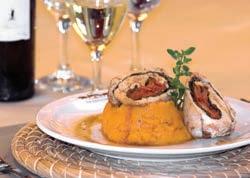





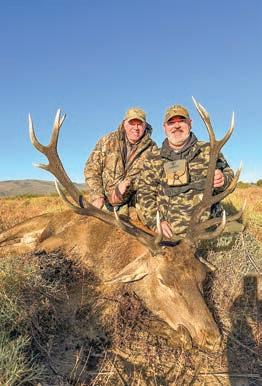



volley. I always call the shot; clients aren’t allowed to shoot until the shot is called, and that is (done) for safety first, and secondly, because I have a better understanding of when to optimize the shot.”
The hunt is only a portion of Townley’s day. Once the clients have departed, he’ll spend his time making sure everything is set up for the next day’s hunt.
“Preparation is one of the keys to success. I am pretty meticulous; the blinds have to be set up just right. I’ll brush and redress the blinds to ensure the cover (camouflage) on and around the blinds is perfect,” he says. “If the

“I’d like to think we are really good at what we do, and we just do our very best to provide a good experience,” Townley says of his goose hunting clients. “Over the years, I have met a lot of really great people and many of them come back to hunt with me every year.” (DAKOTA

A productive
geese see you, they will not come in. Also, the field around the blinds needs to be pristine, meaning the decoys are always nice and straight and nothing is down. I’ll walk the field and pick up all our shotgun wads or any trash. I’ll always check the wind, because you have to move the decoys according to the wind. My wife can attest to this: There are times when I’ll spend three or four hours moving decoys just to make sure everything looks perfect for the next day. All the guides will do a check-in to see if anyone needs help with something. We’re a really tight-knit group and that works out really well.”
It’s all about providing an experience hunters leave impressed with.
“We get a ton of return clients,” Townley adds. “I’d like to think we are really good at what we do, and we just do our very best to provide a good experience. Over the years, I have met a lot of really great people and many of them come back to hunt with me every year.” CS
Editor’s note: To book a hunt with Blosser Outfitters or to learn more, visit Facebook at Blosser Outfitters or contact Tomas Blosser directly at (530) 966-3513. Dakota Townley’s Guide Service is also on Facebook.







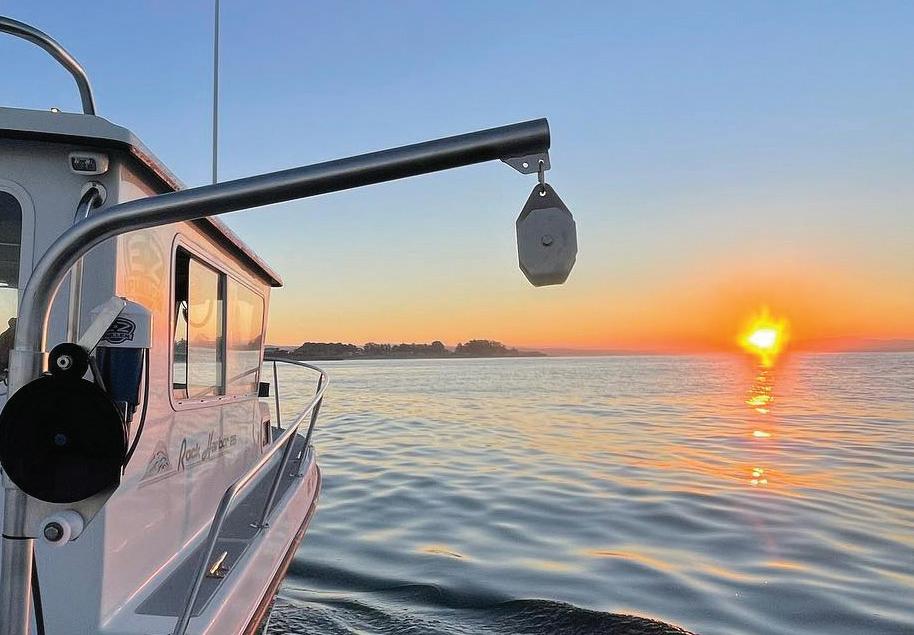
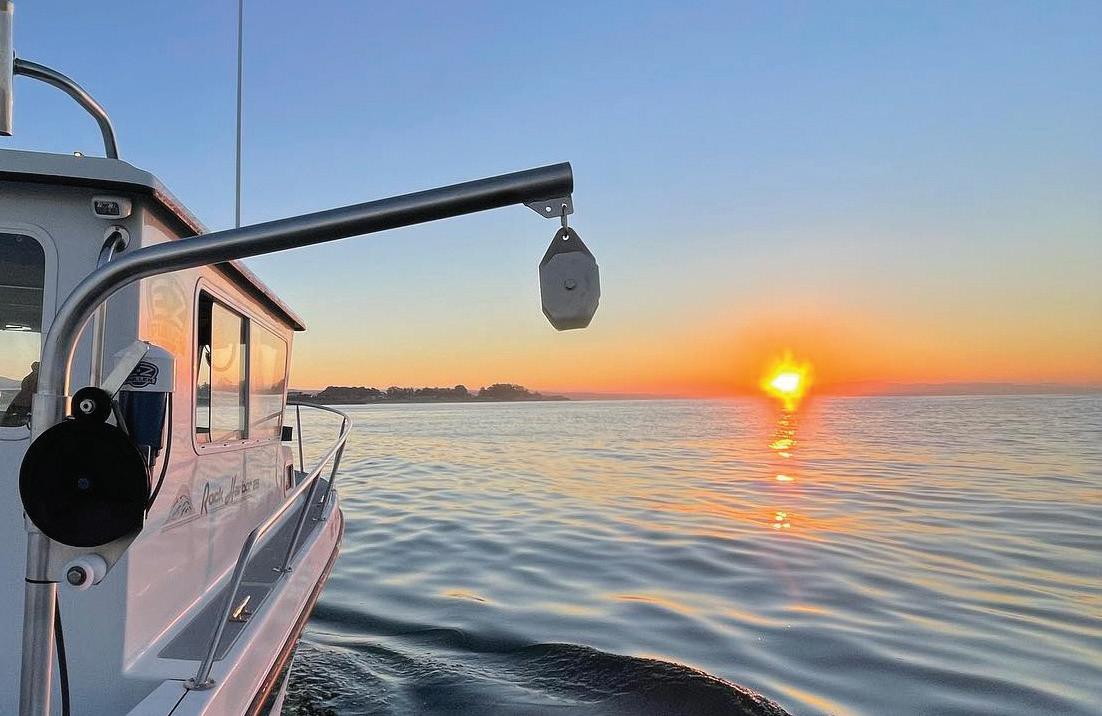









By Tim E. Hovey
My first encounter with a sandhill crane came early in life.
I was 13 and living in Central California. I was riding my bike home from school along a neighbor’s cut wheat field. I had noticed a gray patch in the center, but didn’t pay much attention to it until the patch took flight. The lanky birds were calling loudly as they lifted off, gained altitude and collectively flew over the next field and out of view.
Once home, I looked up the birds of the area in our encyclopedia and found that the sandhill crane was an occasional visitor to the central part of the state. Later I learned that they were not huntable in California, and currently, they still have fully protected status in the state.
As I became more interested in hunting, I’d occasionally see sandhill cranes in marshes and near ponds whenever I hunted waterfowl. I became aware that the species was abundant enough in other states to be hunted, but I knew hunting them in the Golden State was not going to happen.
WHEN I WORKED AS a biologist for the California Department of Fish and Wild-


life, a coworker mentioned that they hunted them often in his home state of Wisconsin. That was the first time that I heard the crane referred to as “the ribeye of the sky!” Much like the mountain lion, I shelved the sandhill crane as a look-but-don’t-touch species for hunters here in California.
Recently, I was offered a writer’s trip to Saskatchewan, Canada, to hunt waterfowl in late September. The trip coordinator, Paul Wait of Delta Waterfowl (deltawaterfowl.org; see sidebar), and I traded emails back and forth for several months. Buried in the logistics
of one of those emails was something that caught my eye: “… And we may get into some sandhill cranes!” The possibility of finally hunting sandhill cranes piqued my interest.
As the trip neared, I started thinking about asking Paul if I could bring someone along with me to Canada. Much like myself, my daughter Alyssa was born a hunter. Now navigating adult life at the age of 24, she has a full-time job and her free time is limited. When I received the approval for Alyssa to go, I called her – her excitement was evident when I asked her if she wanted to go to
Canada and hunt with me.
After a horrendous 15-hour travel day, we touched down in Saskatoon, Saskatchewan, and were picked up by Travis, the outfitter of Honker Heaven Outfitters (honkerheaven.com). On the one-hour drive to the lodge we exchanged small talk and got to know each other. I decided to learn more about the sandhill crane.
Travis was a wealth of information when it came to hunting the lanky birds. I learned that during their roost time in the evening, they prefer hanging out on mudflats near a water source. Unlike waterfowl, which head out at dawn to feed and then return to their water source, cranes will head out in the morning and may never return to their original location.
Sandhill cranes have amazing eyesight; when they are inspecting a decoy spread you can see their heads move back and forth as they survey for danger or for something that just isn’t right. Their shrill call carries an amazing distance and sounds straight out of Jurassic Park. When you first hear the call approaching, you as a hunter know you’re hearing something different.
Despite their huge wingspan and
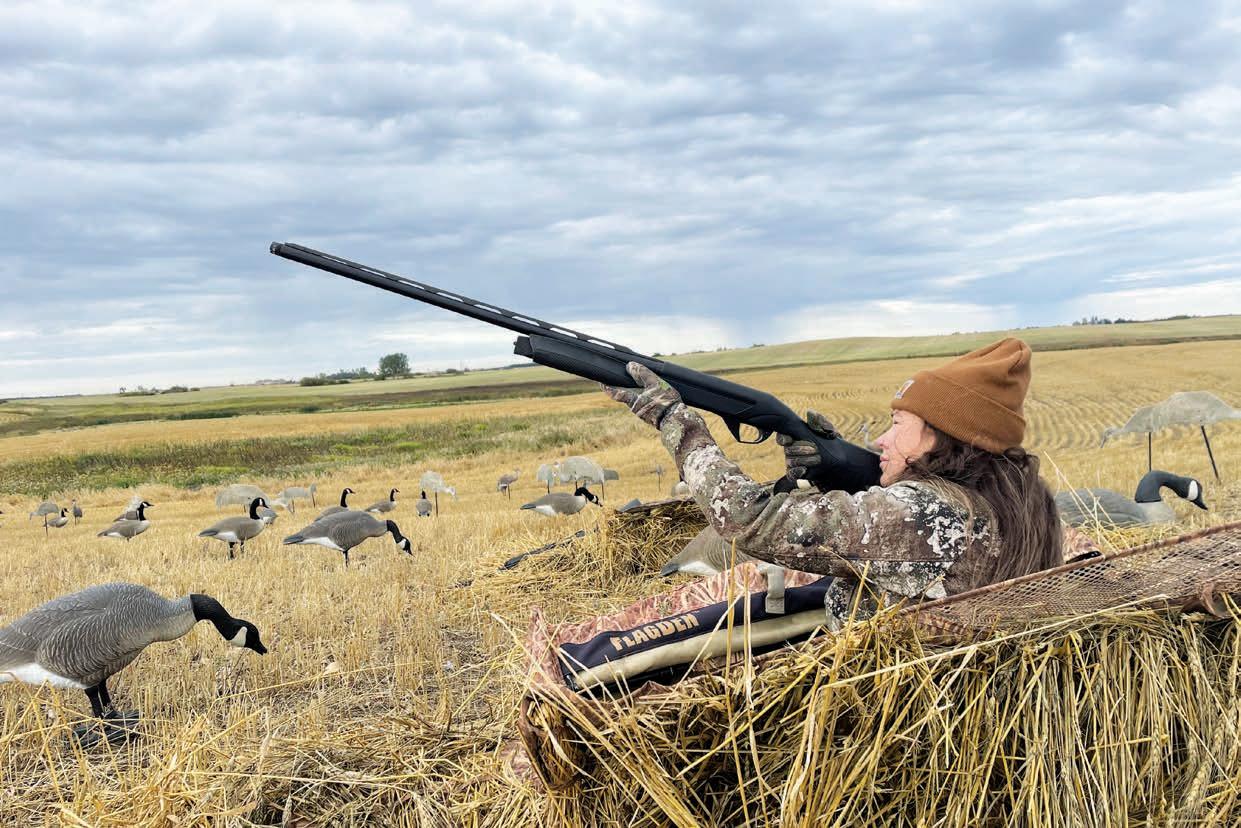
Alyssa Hovey shows off the remarkable wingspan of this species of wading bird. “Despite their huge wingspan and lanky appearance, they are not an easy bird to bring down,” her dad writes. (TIM E. HOVEY)

lanky appearance, they are not an easy bird to bring down. Travis suggested we look to take out the head or neck when we got a shot near the spread. “You don’t want to walk up on a live one looking to stick you with that 8-inch beak,” he said.
I learned that the younger birds have more of a brownish plumage and lack the reddish head crown. Adults will be gray in color and possess a bright red crown of plumage atop their heads. Both adult and juvenile birds will fly together, and Saskatchewan is a very popular seasonal staging area for sandhill cranes. In no uncertain terms, Travis let us know that we were currently in the center of the sandhill crane migration.
WITH LESS THAN FOUR hours of sleep, we found ourselves on that first morning helping set up decoys and
arranging the layout blinds in a crescent formation facing downwind. The decoys were a mix of life-sized, realistic crane decoys and full-body Canada goose replicas. Once the spread was set, we were handed rakes and asked to gather up dead grass to camo up our blinds. Fifteen minutes before shooting time, we were nestled in our layout blinds waiting.
When the sun peeked over the horizon, a dull shrill began to fill the sky. The calling quickly became ear-piercing as the cranes began to fly over our spread. Travis was positioned behind us and unarmed, per the rules of Canadian guiding. A group of a dozen birds banked out front and began to cup their wings in preparation for landing. We were ready.
The group of birds dropped in altitude and positioned their legs to land directly in front of us. With a surge
This trip could not have been possible without the planning and coordination of Paul Wait of Delta Waterfowl. During the lulls in the action, I learned that Delta Waterfowl had active waterfowl research projects in the Saskatoon area and has been involved in bettering waterfowl management for more than a century.
Founded in 1911 and based in Bismarck, North Dakota, Delta Waterfowl prides itself on the abundance of research they conduct to preserve and enhance waterfowl populations all over the United States and Canada. Over the years, the organization has hosted 600 master’s and doctorate students conducting waterfowl research of all kinds. This includes strategic placement of over 15,000 hen houses, the monitoring of canvasback broodstock survival and focused predator management through trapping.
These research projects have resulted in over 950 peer-reviewed scientific papers. This is the epitome of advancing successful waterfowl management through science.
Delta Waterfowl has also initiated a HunteR3 program to boost the number of waterfowl hunters in North America (deltawaterfowl.org/hunter3). This unique program is designed to recruit new waterfowl hunters, retain those currently participating in the activity and reactivate those hunters who have fallen from the hunting fold. Understanding that you cherish and protect what you love, Delta Waterfowl believes that the legacy of the HunteR3 program will yield protection and enjoyment of waterfowl and waterfowl hunting in perpetuity.
For more about Delta Waterfowl, visit deltawaterfowl.org to learn how their efforts have proudly influenced waterfowl, wetland and annual harvest management. TH
of anticipation, Travis gave the command, “Kill ‘em!” In unison, the six layout blinds exploded, and the morning was filled with shotgun blasts. Four adult sandhill cranes fell from the sky.
The morning hunt unfolded in waves of approaching birds as we edged towards our six-man limit of 30 sandhill cranes. After a quick bird count, Travis informed us we had 28 and needed just two more for our crane limit. Paul, the individual who put the hunt together, suggested that Alyssa and another young woman on the hunt, Maggie, bag the last two birds.
After a brief pause, Travis spotted a group of cranes approaching our spread. He did a little calling to get their attention, and here they came. “Get ready!” I whispered to Alyssa right next to me. “I always am!” she said, and I felt myself smile. At about 25 yards, Travis gave the command and Alyssa shot first, crumpling the lead bird. Maggie followed suit, bagging our limit bird before 10 a.m. that first day.
The following two days we hunted hard, twice a day, getting into ducks, Canada geese and, of course, more
sandhill cranes. It became clear to me that the area around Saskatoon was the center of crane and waterfowl movement during the fall.
Just prior to the second evening meal, Travis and his brother, Kevin, brought out an appetizer of grilled sandhill crane breast and heart. Most of our hunting group had never tried it before, myself and Alyssa included. After a couple of bites, we were both convinced it truly did taste just like ribeye. Without a doubt, it was the best wild game I had ever eaten.
I watched Alyssa bag her final sandhill crane of the trip. She went out to grab it and another hunter, Douglas, commented that it had been awesome to see me and my daughter hunt together over the previous few days. He had mentioned that he had a small child at home. I looked over at Douglas and said, “The best hunts of your life are coming with you and your son!”
At the Saskatoon airport, while waiting for our flight, I asked Alyssa a question I already knew the answer


to. “Did you have fun?” Her smile lit me up like it always does and she nodded enthusiastically. I gave her a playful hug and said that having her along made the trip for me. “I couldn’t imagine having anyone else along,” I added. CS





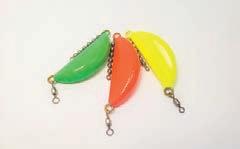






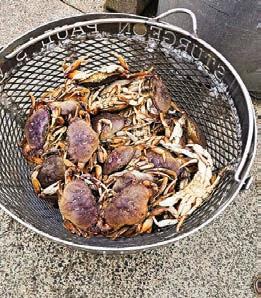















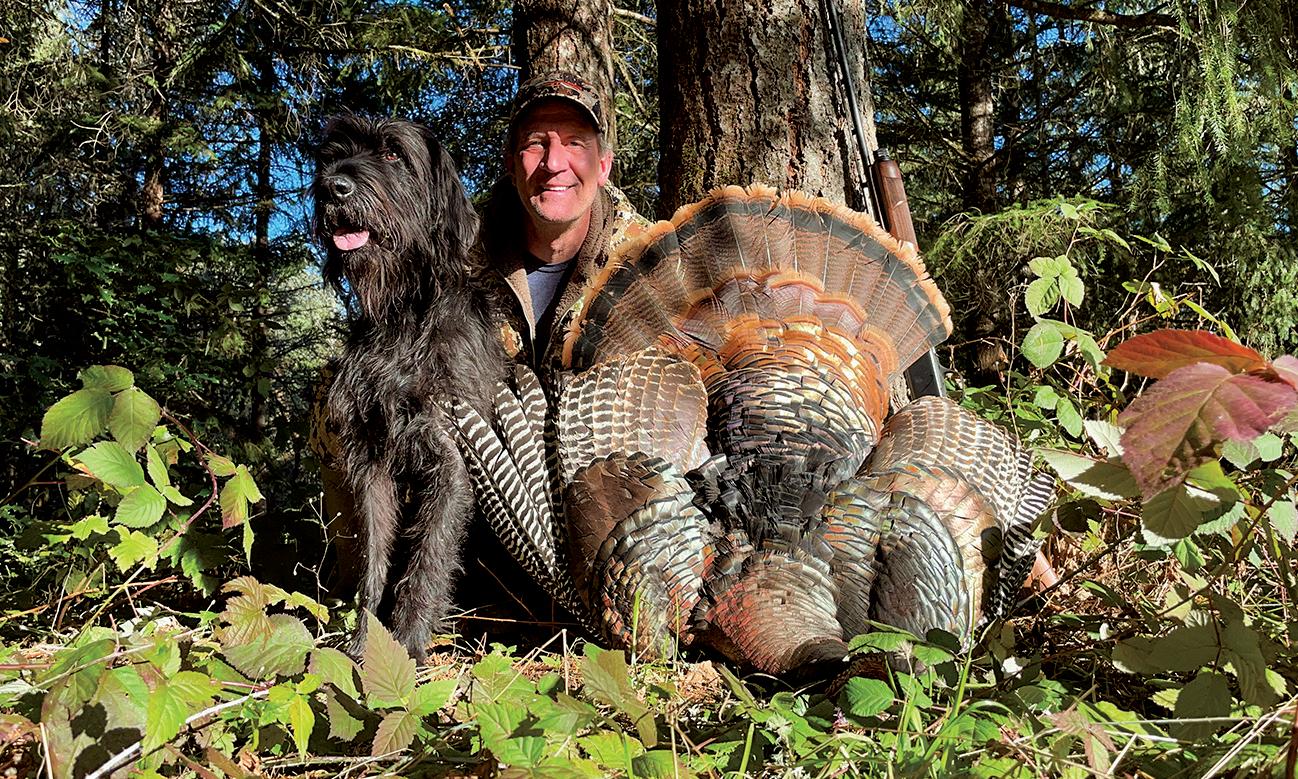



amid the ferns, nose to the ground, sniffing for a bird that held. There were none.
I gave two beeps on the electronic collar and Echo ran back to me. We hiked around the hillside, out of sight from the turkeys. I sat against a giant old-growth stump and Echo tucked under some sword ferns next to me where she laid stone-still.
As turkey chatter escalated in the trees, I let out soft “kee kee” calls with a Slayer Calls diaphragm. The
birds and I talked back and forth and soon they were on the ground. Multiple turkeys came our way. A payload of Hevi-18 TSS from the little .410 dropped a tom at 15 paces.
I HAVE TWO PUDELPOINTERS, Echo and Kona. Both love fall turkey hunting. When they were pups I trained both to hunt for the big upland game birds in autumn.
Echo and Kona have successfully tracked and pointed multiple fall
turkeys. I’ve hunted behind other bird dogs that are good at this too. Turkeys leave a lot of scent on the ground and it’s easy for dogs to follow soon after their passage.
Obedience and instincts make for a good turkey dog. It’s instinctual for upland dogs from a good bloodline to hold point. It’s also important to train for this because turkeys are, obviously, much bigger than quail and are sometimes visible when holding, which can overly excite a dog. Sometimes it’s a lone tom they’ve tracked; sometimes it’s an entire flock. Sometimes turkeys hold; sometimes they run. One of the joys of tracking fall turkeys with a dog is you never know how the hunt will unfold, and that’s where a disciplined dog comes in.
Sending a dog to bust a turkey flock so you can call them back in is a learned behavior. The situation has to be right, and that depends on the habitat and your dog. I’ve learned to not send a dog to break up a flock

unless the birds are feeding uphill into cover.
When the dog returns to me and heels, we hike to the birds, keeping out of sight. It’s thick vegetation

where I hunt and that’s what my dogs lay in for cover. We use no blind.
I HUNT ONE DOG at a time when flushing and calling turkeys; otherwise, the competition gets too high between them. I position the dog at my side so it can see me as well as the turkeys when they approach.
As turkeys come to the call, it’s total restraint and discipline for the dog. If you taught them this from the day you brought them home, it won’t be a problem. If your dog won’t sit still and remain quiet, there’s work to do before embarking upon such a hunt.
When Echo was a pup she whined when turkeys got close. She was perfectly still from day one, but the whining spooked birds. That’s when we headed afield to call turkeys, and I didn’t take a shotgun. Not taking a gun deescalated Echo’s intensity because I was able to put my hand on her and whisper commands –that was step one.
Step two was delivering a single beep on Echo’s e-collar when she whined. She knew one beep meant to stop and that if she didn’t obey,






Turkeys see in color and have 8x vision, so quality camo is key when calling them into your lap. I never owned a piece of Sitka clothing until just over a year ago. Now it dominates my closet. I love the fit, functionality and performance in all situations I’ve tried it in, and their new Optifade Cover pattern matches the West Coast as well as anything I’ve seen in nearly 50 years of hunting this land.

Quality camo can only help when hunting sharp-eyed turkeys, and Scott Haugen has become a big fan of Sitka Optifade Cover, which blends in well with Coast Range forests.
I was able to test the Optifade Cover pattern starting last spring in multiple states amid the Coast Range, valley floors and Cascades. This pattern is made for folks like us.
I’ve never been a fan of photo-finish camo patterns. Camo patterns are about creating depth through the use of larger dark and light contrasting patterns, capitalizing on shadows and rays of light to help create the illusion. Sitka nailed it in their Cover pattern, and the name and performance confirm it. –SH

an intense beep or light shock would follow. By focusing on bad behavior, Echo was quick to learn.
I only had to zap Echo one time. After that she sat quietly. When a hen got within 8 yards and she didn’t make a sound, I was elated and knew Echo was ready to hunt.
To prepare to track fall turkeys, train your dog with wings saved from birds you’ve taken. Take the wings out of the freezer, thaw them to increase scent release, train for two days and then put them back in the freezer. This is a great tune-up. The wings can be cut at the elbow joint, doubling your training tools. Run them on drags for dogs to track and place them for dogs to work the wind. CS
Editor’s note: For signed copies of Scott Haugen’s popular book, Western Turkey Hunting: Strategies For All Levels, visit scotthaugen.com. Follow Scott on Instagram and Facebook.
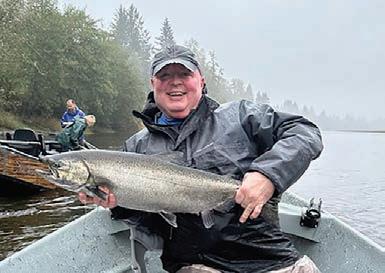



at marine.honda.com or visit your Authorized Honda Marine Dealer.




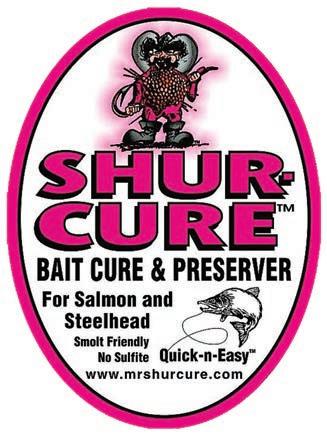










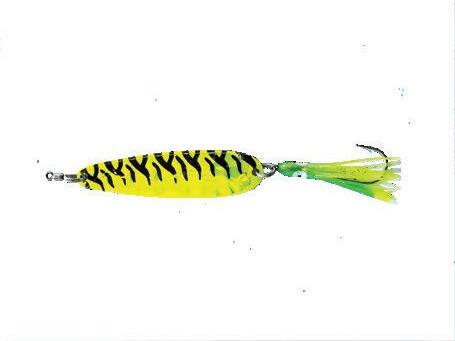







By Cal Kellogg
Thick leaden clouds blocked out the sky and the lake was enveloped in the half light of an approaching fall storm. The greenish-blue surface was alive with wind chop, and I was filled with anticipation. The conditions were ideal, and I knew it wouldn’t be long before the first trout came knocking. I was looking at a bald eagle in
TROUT, MACKS, KOKANEE ON MENU AT UNDERRATED SAC-AREA RESERVOIR

the distance – its snow-white head prominent against the green backdrop of pines as it sat silently on its perch –when the strike came. Maybe I heard the rod squeak in the holder or perhaps caught a flash of movement in my peripheral vision. At any rate, when I looked down the surface rod was bucking wildly; a nanosecond later, a thick, chrome-bright rainbow exploded out of the water behind the boat.
By the time I wrenched the rod from the holder, I was in the fight. The trout shook its head, dove violently and made another wild jump before surrendering to the net, with the bright-orange trolling fly embedded in the corner of its mouth.
This was my introduction to Union Valley Reservoir back in fall 2022. I caught and released 16 hard-fighting rainbows that day before thunder and
lightning drove me off the water. On the drive home, I found it surprising I’d never visited the lake before since it’s less than two hours from my house. I knew I’d be visiting the impoundment regularly in the future!
Some of the folks reading these words know the virtues of Union Valley Reservoir and the outstanding fishing it offers already, but it’s a safe bet most of you have never heard of the lake. If this is the case, then keep reading because if you’re a Golden State angler, Union Valley should be on your fishing radar.
The fact Union Valley is unknown by many isn’t a huge surprise since the lake is located off the beaten path in the 85,000-acre Crystal Basin Recreation Area of the Eldorado National Forest.
As the crow flies, Union Valley
is located approximately 20 miles from Placerville, which isn’t far from the hustle and bustle of downtown Sacramento. Yet it’s hidden in the huge swath of remote forest sandwiched between the Interstate 80 and Highway 50 corridors.
There are a number of streams, lakes and reservoirs in the Crystal Basin that provide excellent fishing, but Union Valley is the recreation area’s crown jewel, offering trophy fishing for browns and Mackinaw, big numbers of rainbows and kokanee, plus a sleeper smallmouth bass fishery.
Union Valley Reservoir was formed in 1963 and this year celebrated its 61st birthday. The lake was formed when the Sacramento Municipal Utility District impounded the waters of Silver Creek, a tributary of the American River, in order to

In spring, fall and winter you can target Union Valley’s trout in the top 15 feet of the water column, but during the summer you’ll need downriggers to get your baits into 30 to 40 feet of water for the best action. (CAL KELLOGG)












generate electricity for Sacramento. Union Valley is the largest of a complex network of reservoirs that make up SMUD’s Upper American River Project.
When at full capacity, Union Valley retains 277,000 acre-feet of water. Sitting at 4,800 feet, the lake is high enough to remain cool all summer, while in winter frigid temperatures and heavy snow are the norm.
The lake has three boat ramps –Peninsula, Jones Fork and Westpoint. Typically, there is access to the Westpoint Ramp all year long. The other two ramps are seasonal and generally open from early spring through late fall. Now, let’s go fishing!
Rainbow trout are the most pursued game fish at Union Valley. There are wild rainbows in the lake that spawn in tributary streams, California Department of Fish and Wildlife planters that run 10 to 12 inches and larger stockers provided courtesy of SMUD that range up to 3 pounds. SMUD planted 10,000 pounds of quality rainbows into the lake in 2024. Planters that aren’t caught by anglers transition into sleek, hardcharging holdovers that grow strong

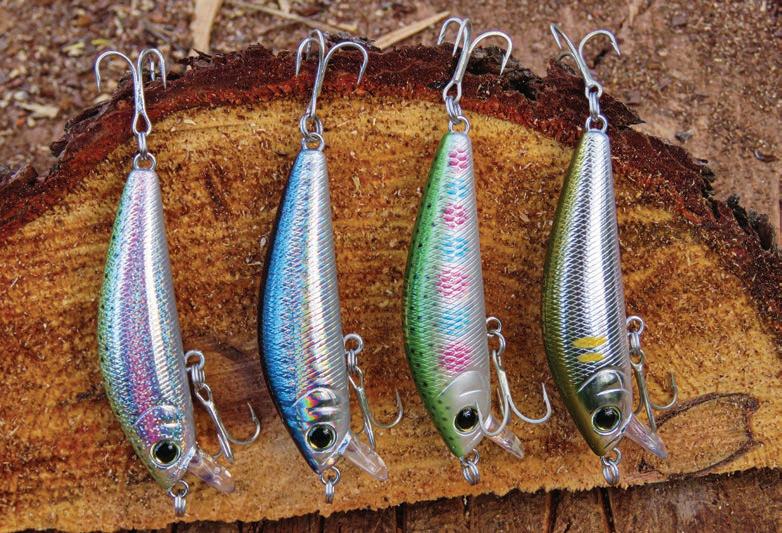
and feed on a mix of insects, small crawfish and baitfish.
You can catch rainbows at Union Valley every month of the year, but the fastest fishing takes place from April through June and during October. In the dead of winter, the rainbows tend to become sluggish due to cold water. During the second half of summer, the rainbows drop down in the water column, where they are constantly surrounded by forage and can become quite finicky, as they only feed for short periods throughout the day.
For boaters, the No. 1 rainbow offering is a threaded nightcrawler trolled from 1.5 to 2 mph behind a set of willow leaf flashers. Most anglers go with chrome blades, but gold or brass blades tend to perform better on



overcast days.
I’ve never been skunked when targeting rainbows at Union Valley, regardless of the season, and I’ve never had to resort to nightcrawlers, although I always have a can or two of worms with me just in case.
During the spring and fall, spoons and trolling flies pulled from 1.8 to 3 mph in the top 20 feet of the water column have produced well. As spring gives way to summer and the fish drop down in the column, I’ve found soft plastics such as Trout Trix worms trolled from 1.5 to 2 mph to be very effective.
For spoons, I prefer gold or copper baits over chromes and silvers, but there are always exceptions. One day I did exceptionally well on frog patterns, so be ready to experiment.
Arctic Fox and Metalhead flies in bright pink, orange and chartreuse patterns have proven to be effective. Some days rainbows prefer naturalcolored plastics, but more often than not they have a tough time passing up bright-orange or bubble-gum-
pink offerings.
Bank anglers will find spring and fall the best times to work standard offerings such as PowerBait, Kastmaster spoons and small CountDown Rapalas. Gold is always a great color choice, but orange offerings can be highly effective at times.
The average rainbow at Union Valley runs about 14 inches, with fish topping the 5-pound mark showing up every year.
MACKS AND BROWNS
Brown trout tend to be smart and difficult to hook, and the big browns residing in Union Valley aren’t an exception to this generalization. While browns show up all year long, early spring and late fall are the hands-down best times to target them.
Certainly browns are caught when the weather is good and the sky is blue, but stormy, blustery days tend to be best for a legitimate shot at trophy fish. During these times, browns move into shallow structures
to hunt, and this is when they are most vulnerable to the efforts of anglers.
Large rainbow trout- and kokaneecolored minnow plugs trolled around 3 mph, combined with a thermos of coffee and plenty of patience, is the best approach to picking a fight with the brown trout of your dreams, but large flies and naked ’crawlers can pay dividends, too, when trolled in the 1- to 2-mph range.
For bank anglers hoping to score a big brown, soaking an inflated ’crawler on one rod and fan-casting a CountDown Rapala on a second rod is your best avenue to glory.
Mackinaw are the heavyweight champs at Union Valley, with fish in excess of 20 pounds landed annually. The period from February to June offers the best Mackinaw fishing, but you can find them lurking around kokanee schools all summer long.
Early-season Macks will grab a variety of trolled offerings, but large spoons, large plugs and whole threaded ’crawlers are best. When the water is cold, say, 50 degrees or less, you can find Macks in the top 20 feet of the water column, but once the temperature gets above 50, they tend to drop down.
Macks can be sluggish early on when the water is frigid, so slowtrolling anywhere from 1.5 to 2 mph with fluttering spoons and large FlatFish is the way to go. Adding a gel scent in a baitfish flavor to your lures can really help the cause. As the water warms, you can speed up your presentation with faster-performing spoons and minnow plugs, but continue using scent.
If you are fishing from a boat or kayak but want a break from trolling or are interested in a new challenge, consider jigging. To effectively jig, you’ll need to locate Macks holding along the bottom with your sonar unit. Once you have some potential targets in sight, yo-yoing metal jigs or soft plastics rigged on lead heads can provide thrills you’ll never experience when trolling.



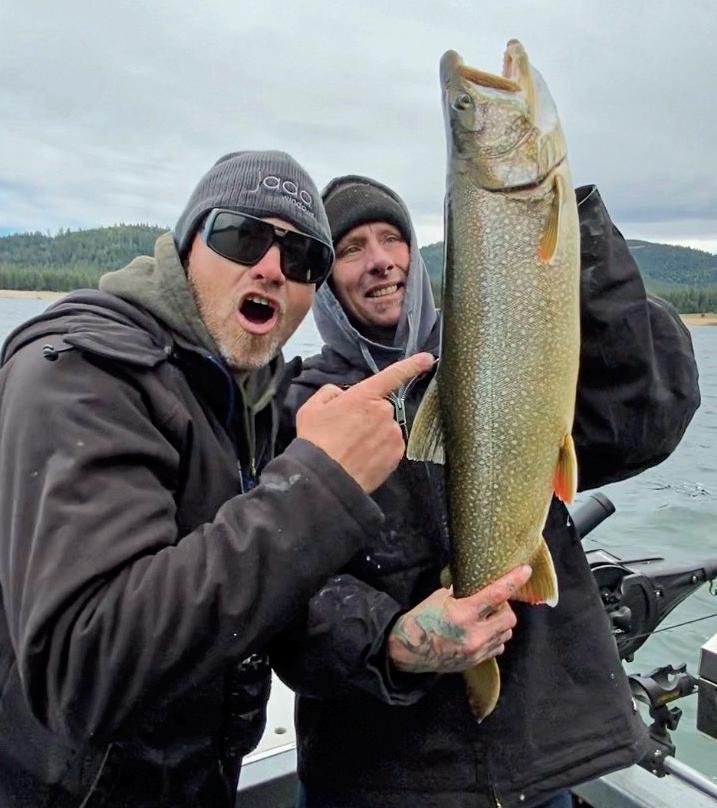
If you favor metal jigs, Crippled Herring, P-Line Laser Minnows and Gibbs Minnows all work. Some anglers don’t think color matters when jigging, but I’ve had my best luck when using glow-white offerings.
In terms of soft plastics, Big Hammer swimbaits are a great choice, but my all-time favorites are the large white or pink Gulp! Grubs used by saltwater anglers targeting lingcod or rockfish. When fish grab Gulp! they tend to hang on.
KOKANEE
When it comes to fighting ability and table fare, kokanee are an angler’s favorite. If you visit Union Valley and
plan on taking some fish home to eat, plan on spending an hour or two chasing the lake’s sockeye salmon.
You can catch kokanee at the lake from April to August, but the best action tends to take place in May and June. You can expect to find schools holding from 20 to 30 feet deep, perhaps shallower early in the day. The area around the dam provides consistent results, with the first couple hours of daylight usually featuring the fastest fishing.
When it comes to kokanee fishing it seems like most anglers employ dodgers these days, but that doesn’t mean naked lures and lures teamed with old-school metal flashers won’t work.
A lot of my friends who fish Union
Valley rely on micro hoochies and bugs pulled behind traditional 4-inch skateboard-shaped dodgers.
My favorite gear for targeting kokanee all over the Golden State consists of a variety of spinners, including the Mack’s Lure Wedding Ring and Uncle Larry’s Spinners. I’ve enjoyed solid results with these baits at Union Valley. Most of the time I team my spinners with Sling Blade-style 4-inch dodgers, but at times when the salmon are acting shy, I’ll run my spinners naked. This approach works well when the bite slacks off later in the morning.
Lure and blade color for kokanee fishing is always a moving target when kokanee fishing. Pink or orange lures generally work well, and glow patterns can be deadly just after dawn. As the sun hits the water and the surface goes glassy, kokanee action tends to slow down.
If you don’t already have your limit, shift away from bold, bright, high-flash offerings in favor of naked lures in mellow colors, and you’ll be able to scrape out a few more hookups most days.
Of course, kokanee and corn go together like peanut butter and jelly, so don’t forget to bring some. Many anglers like to treat their shoepeg corn with exotic concoctions and cures, so I’ll jump into the fray and share my favorite cure.
My approach is a big secret, so keep it to yourself. I open the can of corn and put 3 tablespoons of kernels into a zipper bag. Next, I shake in one teaspoon of non-iodized sea salt for toughness, one teaspoon of white sugar for sweetness and a dash of clear Karo Syrup for general stickiness.
I’ve relied on this concoction for over 30 years, and it seldom disappoints. If my scent doesn’t work, I break out a bottle of Pro-Cure Kokanee Magic Gel. Does Kokanee Magic work? Of course it does. It says “Kokanee Magic” right on the bottle!
As you can see, there’s no shortage of options to have a great day at Union Valley Reservoir. CS

★ New patented EASY to use Bobber With A Brain Jr., ONLY automatic slip bobber in the world that requires no line stopper! You can fish 1 & 2 feet off the bottom automatically any depth, even 50 feet deep and it will not drift in 30 mph wind or jet ski waves!
★ Works in combination with any slip sinker and allows you to fish on and off the bottom at the same time on the same crappie or perch type rig!
★ Sold in three packs on e-bay and website: BobberWithABrain.net or SmartestTackle.com
★ Questions answered by Frank, inventor at Stackle23@msn.com


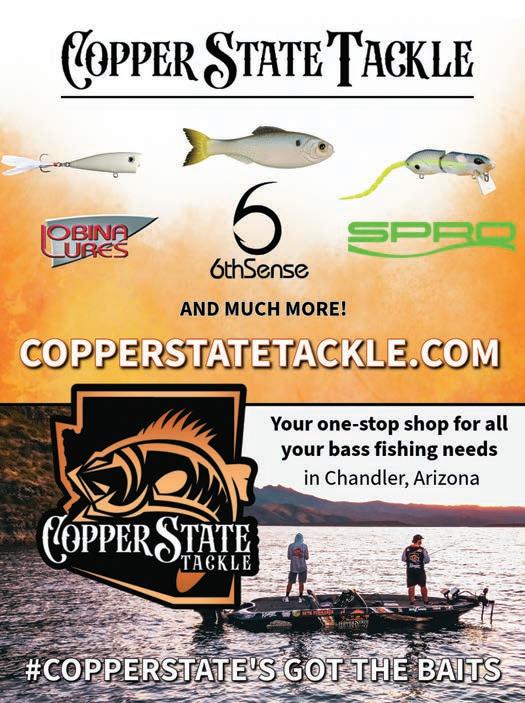




peetdryer.com
In 1968, Gene Peet revolutionized footwear care with the invention of the world’s first shoe dryer. Since then, Peet Shoe Dryer’s unwavering commitment to American manufacturing has been a cornerstone of their success. The Advantage Plus (M2107F) Fan Dryer dries boots, cleats, shoes or skates in just one to four hours, making it the perfect gift and a smart choice for maintaining healthy, dry footwear.

exquisiteknives.com
Selling some of the finest and most collectible custom knives in the world. Owner Dave Ellis is a retired ABS mastersmith as well as a lifelong collector of valuable custom knives. Specializing in Bob Loveless, Bill Moran, Michael Walker and CAS of Argentina. Pictured is the Dragonfly Knife by Dr. Fred Carter. See more on Instagram @daveellis44.

wolfsensausage.com
Wolfsen’s Meat & Sausage offers charcuterie boards made with Wolfsen’s made-in-house turkey, ham, tri-tip, snack sticks, grapes, nuts and cheese.
Wolfsen’s Gift Bags include:
1 small Wolfsen’s thermal bag;
1 pack of sausage;
1 pack of beef jerky;
1 pack of snack sticks;
1 4-ounce bag of Stewart & Jasper nuts; and 1 bottle of Wolfsen’s Sauce.

davistent.com
The sleeping bag cover from Davis Tent is a great way to protect your sleeping bag and add a little warmth. You can even sleep under the stars on a starry night! Roll your sleeping bag, pillow and sleeping pad up and it’s a perfect bedroll to keep all your sleeping gear organized.

stoneflynets.com
Stonefly Nets make a perfect holiday gift for the fly fishing enthusiast in your life. Whether wading through rivers or casting from the shore, this thoughtful gift adds joy to their favorite outdoor adventure, enhancing their experience with quality, ease, and the perfect balance of function and craftsmanship.
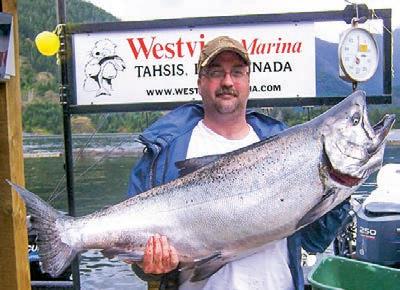
westviewmarina.com
Epic British Columbia, Canada, fishing/ catching adventure. Drive or fly-in, four nights’ lodging, three full days of guided fishing/catching salmon, halibut, lingcod and much more, with all your meals off a large restaurant menu. Price is $2,100 USD each for a crew of four to six people.


Vortex vortexoptics.com
spokanespice.com
Michlitch Company offers a wide variety of jerky and sausage-making seasonings and supplies. For the holiday season, they have gift boxes available for $30 each. Each box includes three seasoning blends and one sauce. Visit the website to see their variety of products and gift boxes.
PocketOx.com
The stocking-stuffer-size Half Calf is the tiniest mini hoist offered by Pocket Ox. A cut-down version of their 1,000-pound 8:1 Calf hoist, hence the name, the Half Calf is truly a block and tackle that will fit in a pocket. Standard 50 feet of “rope” has a block-to-block reach of 12 feet. May be ordered with 100 feet, doubling that distance while adding less than an ounce of carry weight.
libertygamecalls.com
Vortex performance sunglasses are here to bridge the gap between hyper-tactical eyewear and uncomfortable safety glasses, delivering UV and ballistic-rated protection, comfort, versatility and casual style. Vortex perfor mance eyewear is available in two styles, the Jackal and Banshee, and multiple lens colors in each style.


Liberty Game Calls are predominantly made of rubber, setting them apart from plastic game calls on the market. Rubber is soft and flexible and has exceptional sound transmission properties. Rubber’s high elasticity enables it to absorb and dissipate sound energy more effectively. This ensures that sound waves are not reflected or prematurely absorbed, allowing them to carry further and more efficiently. Rubber’s low density and significant internal damping produce deeper, more resonant sounds. Rubber is the perfect material for calling game where the highest sound transmission and quality are essential for attracting game.

KatchKooler Deluxe silverhorde.com
The KatchKooler Deluxe “Keeps Your Catch Fresher.” The compact design makes it easy to stow. A high-density closed-cell foam layer will keep your fish extra cold. Made with durable waterproof outer fabric and equipped with a strong handle. Excellent for transporting fish. It’s the perfect gift for the angler in your family.
fishhuntersguideservice.com
Holiday special! The more people in your group, the more you save! Up to $200 in savings!
**$50 off the purchase for two guests, $75 off the purchase for three guests, $100 off the purchase for four guests, $150 off the purchase for five guests, and $200 off the purchase for six guests. This offer expires 1/1/25.

godarkbags.com
Safeguard your satellite phone with the GoDark Faraday Bag, designed to be highly water- and puncture-resistant. This innovative bag effectively blocks satellite signals, Wi-Fi, Bluetooth, GPS, 5G and EMP interference. It features MOLLE straps on the back for convenient attachment to belts or bags, along with a secure magnetic buckle that allows for easy one-handed access.


safejacks.com
Safe Jack solves century-old stability and safety issues related to farm jacks and the classic bottle jack. The most common failure is not linked to the jack itself but to stability, too much ground loading in one spot, and the lift point. Check out these kits!

coastalmarineengine.com
Get 10 percent off labor on any scheduled maintenance between January 2 and February 28. Please use discount code NWSM2025 when booking your service.

nradventures.com
Join Northern Rockies Adventures’ signature fly-in fishing trips and enjoy the gold standard of Canadian trips! The secret to their great fishing lies in over 70 remote fly-in fishing destinations. Catch all wild native freshwater fish: trophy rainbow, bull and lake trout, northern pike, Arctic grayling and walleye. Premium all-inclusive trips from Vancouver, B.C.

fishermansgold.com
Flounder Pounder Cinnamon Twist three-pack for $11.99. Best soft bait for bottomfishing. These high-quality baits won’t degrade over multiple uses and are made specifically for West Coast fisheries.


The Black Hills 6mm ARC 90-grain Dual Performance load is designed to shoot flatter to 600 yards compared to the 103-grain ELD-X introduced last year, plus open immediately upon impact to create a large, 7-inch-diameter wound channel. Velocity is 2,650 feet per second with over 1,400 foot-pounds of energy.

youtube.com/@UncleNormsMarine Uncle Norm’s Performance Fins cut through the water, decreasing turn radius and boat wander for better slow-speed control and docking ability. The horizontal fluke area across the top blocks the prop from drawing water from the surface, effectively eliminating ventilation. You’ll get on plane faster and gain a smoother ride.
mcomiescustom luresllc.com
McOmie’s Custom Lures’ 3.5 Colorado spinners with squid skirts and 3.5 Colorado blades make perfect stocking stuffers for the fishing family.

jimteeny.com
Teeny, Inc. Fly Lines is offering their $50 coffee table book for $25, which includes free shipping in the United States. This book is hardbound, full-color, and full of stories and photos. A great personal gift!



